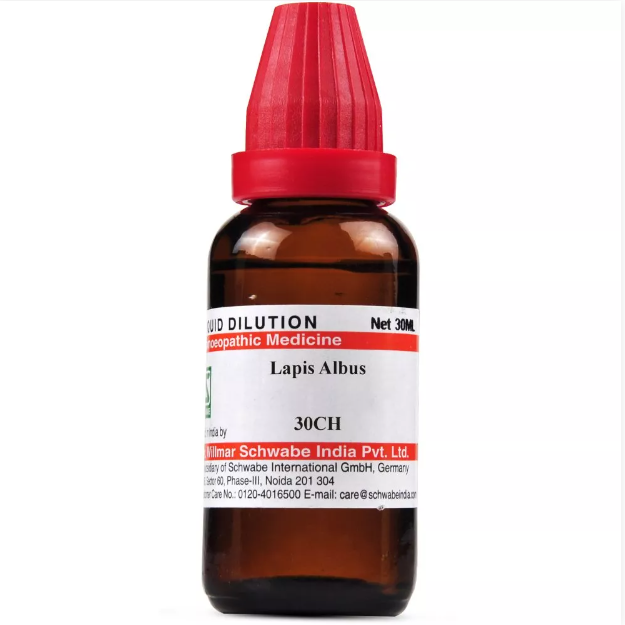LAPIS ALBUS 6C, 12C, 30C, 200C, 1M, 10M USES AND SYMPTOMS
 LAPIS ALBUS
LAPIS ALBUS
(Silico-fluoride of Calcium)
Lap-a.
Gland issues, goitre, and early-stage carcinoma. Burning, stinging pain in breast, stomach, and uterus (carcinogenic stage). Connective tissue around glands is particularly affected. Fatty, anemic babies with a ravenous appetite. Highly effective in scrofulous conditions, except in malarial cases. Uterine carcinoma and fibroid tumors with intense burning pains and heavy bleeding. Glands are elastic and pliable, not as hard as in Calc-f. and Cist.
Ears: Otitis media suppurativa. Speeds up progress when Sil. is indicated (Bellows).
Chest: Persistent pain in the mammary region. Glandular hardening.
Skin: Scrofulous abscesses and sores. Enlargement and hardening of glands, especially cervical. Lipoma, sarcoma, carcinoma. Pruritus.
Relationship: Compare with Sil., Bad., Ars-i., Calc-i., Con., Kali-i., Aster.
Dose: First to sixth potency.
SYMPTOMS OF LAPIS ALBUS
Ears:
Otitis media suppurativa,
Speeds up progress when Sil. is indicated.
Chest:
Persistent pain in the mammary region,
Glandular hardening.
Skin:
Scrofulous abscesses and sores,
Enlargement and hardening of glands,
Especially cervical, lipoma,
Sarcoma, carcinoma, pruritus.
selection of the potency
Individualization:
- Homeopathy is based on the principle of treating the individual, not just the disease. The unique symptoms and characteristics of the person are crucial in determining the most suitable potency.
Intensity of Symptoms:
- The intensity of the symptoms guides the choice of potency. If the symptoms are intense and acute, a lower potency (e.g., 6C, 30C) might be considered. For chronic conditions with less intensity, higher potencies (e.g., 200C, 1M) may be appropriate.
Sensitivity of the Patient:
- Some individuals are more sensitive to homeopathic remedies, while others may require higher potencies. The practitioner considers the patient’s sensitivity when selecting the potency.
Acute vs. Chronic Conditions:
- Lower potencies are often used for acute conditions, while higher potencies may be considered for chronic or long-standing issues.
Previous Response to Potencies:
- The patient’s response to previous homeopathic treatments helps guide the choice of potency. If a particular potency has been effective in the past, it may be repeated or adjusted as needed.
Vital Force and Susceptibility:
- Homeopathy views illness as a disturbance in the vital force. The practitioner assesses the patient’s overall vitality and susceptibility to determine the appropriate potency.
Aggravation or Amelioration:
- The direction of the symptom response (aggravation or amelioration) after taking a remedy can influence the choice of potency.
Miasmatic Considerations:
- In classical homeopathy, the concept of miasms (inherited disease tendencies) is considered. The practitioner take this into account when selecting the potency.
Practitioner Experience:
- The experience and preference of the homeopathic practitioner play a role. Some practitioners may have success with certain potencies based on their clinical experience.
SAFETY INFORMATION
- Do not exceed the recommended dose by physician
- Keep out of the reach of children
- Store in a cool dry place away from direct sunlight
- Maintain half an hour gap between food/drink/any other medicines and homoeopathic medicine
- Avoid any strong smell in the mouth while taking medicine e.g. camphor, garlic, onion, coffee, hing
Medicine images use for reference only selection of homeopathic medicine depends on the individual’s specific symptoms and overall constitution. Moreover, homeopathy is a holistic system of medicine that treats the individual as a whole. In addition to addressing the physical symptoms, it takes into account the emotional and mental state of the person. Consequently, it’s crucial to consult with a qualified homeopathic practitioner for personalized treatment.
The information provided on this website is intended solely for educational purposes. Always seek the advice of your physician or other qualified health provider.
